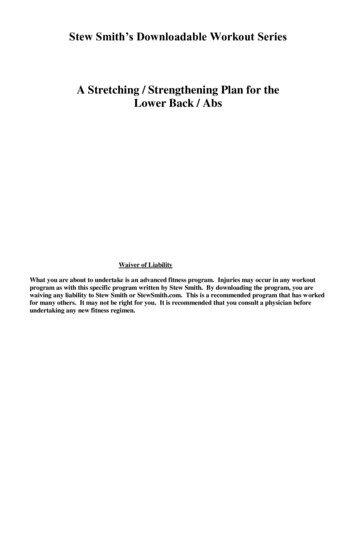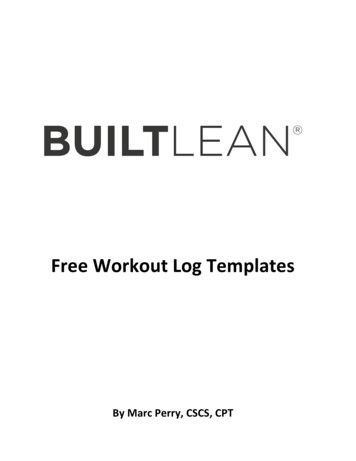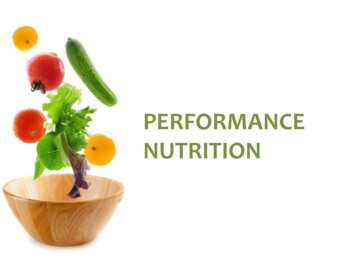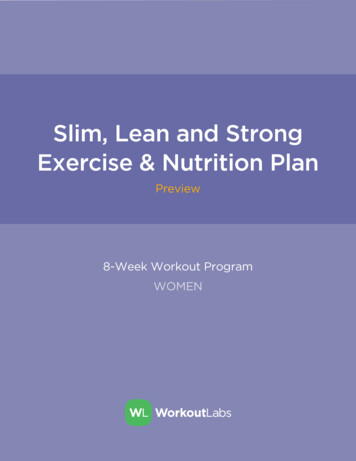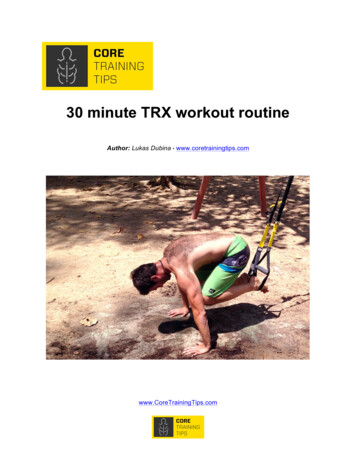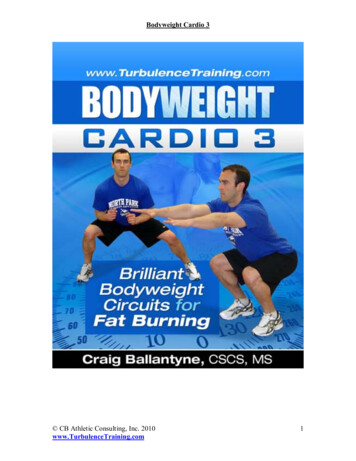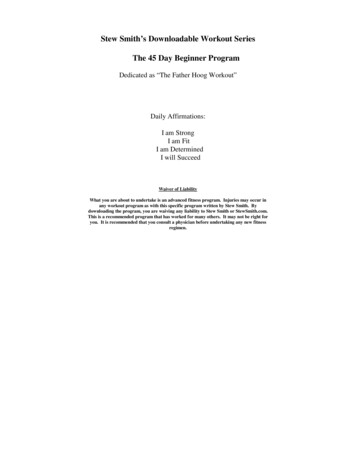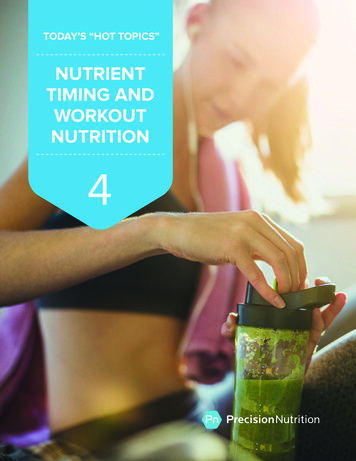
Transcription
TODAY’S “HOT TOPICS”NUTRIENTTIMING ANDWORKOUTNUTRITION4
TODAY’S “HOT TOPICS”NUTRIENT TIMINGAND WORKOUT NUTRITION01IS NUTRIENT TIMING DEAD?AND DOES WHEN YOU EAT REALLY MATTER?02WORKOUT NUTRITION ILLUSTRATED [INFOGRAPHIC]WHAT TO EAT BEFORE, DURING, AND AFTER EXERCISE.03WORKOUT NUTRITION EXPLAINEDWHAT TO EAT BEFORE, DURING, AND AFTER EXERCISE.
IS NUTRIENT TIMING DEAD?And does when you eat really matter?By Brian St. Pierre“Nutrient timing” sounds impressive. Science-y. The way sportand exercise people throw it around, you’d think it must bepretty important.But is it really? Does when you eat really matter? For health?For body composition? For performance?Let’s take a closer look and find out.
Nutrient timing — simplifiedNutrient timing simply means eating specific nutrients (such as proteinor carbs) in specific amounts at specific times (such as before,during, or after exercise).Researchers have explored this practice from different angles overthe last few decades. And their findings have generated a lot ofexcitement.In the early 2000s, with the publication of Nutrient Timing: The Futureof Sports Nutrition by Drs. John Ivy and Robert Portman, the idea ofnutrient timing became the “Next Big Thing.”Seriously, every sports nutritionist worth their branched chain aminoacids owned a copy. Including yours truly. I even wrote a few collegepapers on the topic.And our very own Dr. John Berardi — JB, as he’s known around here— was one of the early researchers in this area.Much of his Masters and PhD research was done looking at nutrienttiming and how it affected recovery from very intense exercise. Heeven contributed to the aforementioned nutrient timing book.Postworkout and anytime mealsNo surprise, the concept of nutrient timing worked its way intoPrecision Nutrition’s general recommendations. We divided mealsinto post-workout (PW) or anytime (AT), these categories implying thatdifferent meals should be eaten at different times of the day.Today’s “Hot Topics” Nutrient timing and workout nutrition.precisionnutrition.com
For example: PW meals are higher in carbs, especially faster-digestingstarchy carbs (such as potatoes or rice) or sweeter carbs(such as fruit). AT meals are lower in carbs, focusing more on lean proteinplus healthy fats and high-fiber vegetables.The scientific evidence — limited at the time — seemed to show thatthis strategic placement of carbs could help hard-exercising peopleperform better while getting leaner, stronger, and healthier.But the evidence wasn’t limited to athletes. Even type 2 diabeticsrespond better to carbohydrates after a carbohydrate-depletingworkout. Thus, our PW/AT recommendations were born.But things have changedJust like JB’s choice of facial hair, and my transition from athlete todad, things have changed in the last 10-15 years.Well, not so much changed. Rather, our knowledge has deepened, asit always does when more research becomes available.Since the early 2000s, for example, we’ve discovered that some ofthose early studies had design flaws or weaknesses. First, they were mostly short-term — spanning a few weeks ormonths, maybe even just a few workout sessions. Because ofthis, they didn’t really tell us what would happen over a longertime span.Today’s “Hot Topics” Nutrient timing and workout nutrition.precisionnutrition.com
Second, they considered what we call “soft” end-points,such as protein synthesis, glycogen replenishment, or nitrogenbalance. Because of this, we didn’t have data on “hard”endpoints such as actual fat loss or lean mass gain.Interestingly, as more long-term data appeared, nutrient timing startedto seem like less of a universal solution.Sure, there were still strong indications that it could be useful andimportant in certain scenarios. For example, many of our clientsreported fantastic results. Plus, there’s the famous and often-cited2006 study by Cribb and Hayes.In that study, the researchers showed that protein, carbohydrates, andcreatine taken around a training session could lead to more musclemass and strength gain than those same nutrients eaten further fromthe session.Unfortunately very few people talk about the flip side: Furtherresearch, using similar protocols, failed to find the same effect.Nutrient timing may not be all that importantSo, what do we make of this?Well, research studies aren’t perfect. And findings don’t always agree.So rather than duking it out on a study-by-study basis, I’ll bottom-line itfor you.Based on the current body of research, and PN’s experience withover 100,000 clients, I’ve come to realize that nutrient timing isn’tparticularly important for most people trying to look and feelbetter.Today’s “Hot Topics” Nutrient timing and workout nutrition.precisionnutrition.com
Let me be clear: no, I don’t think nutrient timing is dead, worthless,whatever. In certain situations it’s probably really important. (We’llexplore them below.)However, lots of really smart and hard working people are getting lostin the finer points of nutrient timing, while consistently missing out onsleep, or vegetables, or other — more important — health and lifestylefactors. And that’s a shame.So, that’s my bottom line. But, if you’re up for it, let’s go a little deeper.Post-workout “anabolic window ofopportunity”For years, the Holy Grail of nutrient timing research has beensomething we call the post-workout “anabolic window of opportunity.”The basic idea is that after exercise, especially within the first 30-45minutes or so, our bodies are greedy for nutrients.In theory, movement — especially intense movement, such as weighttraining or sprint intervals — turns our bodies into nutrient-processingpowerhouses.During this time our muscles suck in glucose hungrily, either oxidizingit as fuel or more readily storing it as glycogen (instead of fat). Andpost-workout protein consumption cranks up protein synthesis.In fact, one study even showed that waiting longer than 45 minutesafter exercise for a meal would significantly diminish the benefits oftraining.Today’s “Hot Topics” Nutrient timing and workout nutrition.precisionnutrition.com
Hurry, the anabolic window is closing!With these physiological details in people’s minds, it became gospelthat we should consume a fast-digesting protein and carbohydratedrink the minute our training ended.Or, even better, immediately before training. (Maybe even duringtraining, too, just for good measure.)It seemed that the faster we could get these nutrients into oursystems, the better. Seriously, I couldn’t have been the only one whostarted to panic the second the last dumbbell hit the floor, rippingopen my sports drink container with fumbling fingers, desperate tocatch that magic protein synthesis train.Go! Go! Go! Anabolic window is closing!Today’s “Hot Topics” Nutrient timing and workout nutrition.precisionnutrition.com
The only problem: Research supporting this idea was short-term.And just because we see positive effects in the short-term (like, inthe next half-hour) doesn’t mean these effects will contribute tolong-term results (like, in 3 months).In fact, recent longer-term studies, as well as two incredibly thoroughreviews, indicate that the “anabolic window of opportunity” isactually a whole lot bigger than we used to believe.It’s not a tiny porthole that you practically have to squint to seethrough. It’s a huge, cathedral-like opening.Chill out man, there’s still timeWhile it’s still wise to bookend your training with protein andcarbohydrates, you probably have one or two hours on both sides ofyour training to get those benefits. What’s more, for most people —save a few specific types of athletes — it doesn’t seem to matter howfast you digest things.So imagine this:Rather than worrying about slamming down some waxy maize starchand whey hydrolysate immediately after training, shoving people outof the way on your mad dash to your gym bag for your Super Shakebottle, you can actually drive home, take a shower, prepare, and eat adelicious whole food mixed meal.To back up this idea, recent data suggests that the total amountof protein and carbohydrate you eat, over the course of the day,is more important for body composition and performance thannutrient timing strategies.Today’s “Hot Topics” Nutrient timing and workout nutrition.precisionnutrition.com
So, make no mistake, we’re not done with workout nutrition. Rather,we’re simply more open to the idea that there are several ways to eatfor performance and body composition.In other words, there’s no one, immutable, do-it-this-way-or-you’rescrewed approach. When is there ever?How about meal scheduling?Eager gym-goers and researchers have also wondered about anothernutrient-timing concept: if there’s a “best time” to eat.For years, most nutrition experts told people to eat more of theircalories and carbs at breakfast, and to keep calories — and especiallycarbs — lower at night.Then, all of a sudden, some newfangled experts beganrecommending the opposite, telling us to eat the majority of ourcalories and carbohydrates at a dinner-time feast. (Nowadays this ideais associated with something called carb back-loading.)So who’s right?The breakfast clubThe research in this area remains limited, but it is interesting.A recent study asked: Does it matter whether you eat half your day’scalories at dinner or at breakfast? And, by “matter,” the researchersmean: would it affect body weight, waist circumference, appetite, andseveral blood markers of glucose tolerance and insulin sensitivity?Well, the group who ate half of their daily calories at breakfast lostToday’s “Hot Topics” Nutrient timing and workout nutrition.precisionnutrition.com
more weight and more inches from their waists, showed greaterimprovements in glucose control and insulin sensitivity, and reportedbeing more satisfied (along with having lower levels of grehlin, ourmain hunger hormone).Wow. Clearly eating more calories at breakfast is the way to go, right?No, no it’s all about dinnerNot so fast. The “carbs and calories at dinner” folks can also call onresearch to support their views.Take, for example, the Journal of Nutrition study that compared eating70 percent of your calories at night versus eating them at breakfast.In highly controlled settings, where all subjects completed resistanceand aerobic exercise, the calories-at-dinner group retained moremuscle and lost an equal amount of body fat to the calories-atbreakfast group!Not only that, but more recently, a six month study found that weightloss, waist circumference, and body fat loss were all greater whenthe majority of the day’s carbohydrate intake was at night, rather thanspread evenly throughout the day.The “more carbs at night” protocol was also better at improvingglucose control, markers of inflammation, blood lipids, and appetite.OK, forget the scheduleSo who’s right? The breakfast advocates or the dinner advocates?Well, it depends.Today’s “Hot Topics” Nutrient timing and workout nutrition.precisionnutrition.com
Some research has found breakfast to be the best time for big meals(3 studies), some has found no differences in weight loss between bigbreakfasts and big dinners (2 studies), and other research has foundsignificant benefits from eating more at night (2 studies).What can we discern from this contradictory mish-mash of findings?Really, it’s simple:We’re all unique. There’s no one-size-fits all rule.Indeed, research into circadian rhythms has found that humans (andanimals) vary a lot in their natural sleep-wake cycles. So why wouldn’tthe same diversity be true of our natural feed-fast cycles?The take-home message:Follow your evidence. Track your experience. Do what works —measurably — for you. Flow with your natural inclination, and whereyour own self-experimentation takes you.If early sunshine and scrambled eggs gets you through the day feelingawesome, great. If a robust dinner is more your thing, enjoy drifting offto sleep with the warm fuzzy feeling of a full belly.Just like when you exercise, what’s most important is that you makehigh-quality choices, consistently, whenever it works for you.But what about no breakfast?The “calories at breakfast” vs. “calories at dinner” debate also raisesthe question: What about skipping breakfast?Today’s “Hot Topics” Nutrient timing and workout nutrition.precisionnutrition.com
Wait a minute. No breakfast?Surely everybody knows that breakfast is the most important meal ofthe day! And, in particular, that it’s a good idea to eat most of our carbsin the morning.Well, at least that’s what my grandparents always told me.Behind this recommendation lies the notion that by breakfast time,we’ve fasted for eight to twelve hours. Our bodies are thereforeprimed to use nutrients (and especially carbs) more effectively than atother times of the day.Our glycogen levels, especially those in our livers, are running low.Plus, some evidence does suggest that we use carbohydrates moreeffectively in the morning than at night.So it seems only logical to make sure we take in more carbs atbreakfast than at dinner. Right?By now I hope you see how this argument falls apart.It’s not that having breakfast is wrong; or that having carbohydrates atbreakfast is wrong. In fact, both choices are just fine.What’s wrong is the assumption that what works for you isnecessarily what’s best for everyone.Today’s “Hot Topics” Nutrient timing and workout nutrition.precisionnutrition.com
Shattering the breakfast mythWhile almost everyone in nutrition, for the last 20 years, has repeatedthe “breakfast is the most important meal of the day” story, it turns outthat this argument in favor of breakfast is actually quite weak.The only support comes from correlational research (X and Y happenat the same time), and not causal research (Y happens because of X).And that makes the “evidence” flawed.In a recent American Journal of Clinical Nutrition paper, researchersanalyzed dozens of studies to look at the relationship betweenbreakfast and body weight. Their conclusion: The commonly cited linkbetween eating breakfast and lower body weight is “only presumedtrue.”Today’s “Hot Topics” Nutrient timing and workout nutrition.precisionnutrition.com
Presumed true. As in “People think it’s true.” Not for-sure true. As in,“We know it’s true.”That doesn’t sound terribly definitive, does it?Of course, just because one study came to a certain conclusiondoesn’t mean the case is closed.So let’s take a closer look at some of the proposed benefits of eatingbreakfast.The benefits of breakfastIn the literature, eating breakfast is consistently associated with: decreased overall appetite; decreased overall food consumption; decreased body weight; improved academic performance; and/or improved blood sugar control.If we stopped there, of course we’d assume that skipping breakfast isa dumb move. However, we can’t stop there. Because, again, most ofthis evidence is observational. It suggests there’s a relationship — acorrelation — without proving a cause.So here’s the bottom line: When examining research that actuallycontrols for all the variables and looks at cause and effect, the resultsare pretty mixed.Today’s “Hot Topics” Nutrient timing and workout nutrition.precisionnutrition.com
In other words, breakfast looks to be beneficial for some of us. Butnot for others. The strongest of this evidence suggests that breakfastis most important for malnourished or impoverished children. But, forother populations, it seems to be just another meal. No better. Noworse. Completely negotiable.The benefits of no breakfastIf breakfast isn’t all it’s cracked up to be, what about skippingbreakfast? Because — you guessed it — some research actuallysuggests that skipping breakfast might make you stronger, leaner, andhealthier. (By now, my grandparents must be groaning.)For example: Folks with Type 2 diabetes did better when they skippedbreakfast altogether and ate a larger lunch. Other folks who were told to skip breakfast ended up eatingless overall compared to breakfast eaters. And skipping breakfast was found to be just as effective aseating breakfast for weight loss.So, will skipping breakfast be better for you?Maybe yes. Maybe no.Preliminary evidence suggests that skipping breakfast can: increase fat breakdown; increase the release of growth hormone (which has anti-agingand fat loss benefits); improve blood glucose control;Today’s “Hot Topics” Nutrient timing and workout nutrition.precisionnutrition.com
improve cardiovascular function; and/or decrease food intake.However, the truth is, most of this research has been done in animals,with only a few conclusive human studies.So, while intriguing, there’s certainly no guarantee that these changesin our physiology will actually lead to long-term benefits.In fact, if there’s one thing we can say for sure, it’s that immediatechanges like these can often be deceiving. Often the body “corrects”for them later — seeking homeostasis.In other words, acute changes don’t always lead to chronic ones.That’s why short-term effects from nutrient timing protocols don’talways translate into the long-term changes we’re hoping for.Is changing your breakfast routine most important?Finally, a recent study offers a fascinating postscript to the breakfastand weight loss question.Researchers broke people up into one of four groups:1. Habitual breakfast skippers assigned to eat breakfast2. Habitual breakfast skippers assigned to skip breakfast3. Habitual breakfast eaters assigned to eat breakfast4. Habitual breakfast eaters assigned to skip breakfastGuess what? The groups whose habits and routines were changedwere the ones with the most substantial weight loss.Today’s “Hot Topics” Nutrient timing and workout nutrition.precisionnutrition.com
The people who normally ate breakfast and skipped it during thestudy lost weight. And the people who normally skipped breakfast andate it during the study lost weight.Ultimately, this study showed that when people become more awareof their intake, they get better results — whether they eat breakfastor skip it.So in the end, eating or skipping breakfast is purely a matter ofpreference.There is no right or wrong choice, as long as whichever choice youmake is actually helping you improve your health, performance, andbody composition.What about meal frequency?Let’s explore one more “nutrient timing” idea.For years dietitians and nutritionists (myself included) thought that thebest approach to splitting up your daily food intake was to eat smallmeals frequently throughout the day. In college I ate eight times perday. Yes, eight!From early research we assumed that eating often would speed upthe metabolism, help control the hormones insulin and cortisol, andmanage the appetite.However, a recent review in the Journal of the International Society ofSports Nutrition, and other lines of evidence, suggest otherwise:As long as we eat the right foods in the right amounts, mealfrequency seems to be a matter of personal preference.Today’s “Hot Topics” Nutrient timing and workout nutrition.precisionnutrition.com
You can eat lots of small meals each day (i.e. every few hours). Or youcan eat a few big meals each day (i.e. with bigger time gaps betweenthem). And there’s almost no physiological difference.There could be psychological differences, mind you. Which is why Ihighly recommend listening to your own body. And why not apply JB’sfamous “How’s that workin’ for ya?” test.If you’re covering all your other bases and your current mealfrequency isn’t working, try switching it up. Experiment with fewermeals if you eat more frequently. And more meals if you eat lessfrequently.Because either approach is physiologically valid, you’re free to find thelifestyle approach that works best for you.(And, of course, expert coaching can really help fast track this process.If we can help — it’s what we do — give us a shout.)Today’s “Hot Topics” Nutrient timing and workout nutrition.precisionnutrition.com
When nutrient timing still mattersMake no mistake, nutrient timing is a complex subject. It’d take anentire book to cover it exhaustively.So, for now I pose this question: Is nutrient timing dead?The answer: Of course not!There are legitimate uses of nutrient timing for certain people. (Moreon this below.)Just remember this:Nutrient timing can be helpful. Or it can add layers of unnecessarycomplexity. It all depends on the context.If you’re a bodybuilder or endurance athlete, the meaning of nutrienttiming is much different than if you’re an overweight office worker justgetting into exercise and trying to improve your nutrition.Today’s “Hot Topics” Nutrient timing and workout nutrition.precisionnutrition.com
Indeed, if you’re just starting out — and looking to get healthierand more fit — you don’t need specific nutrient timing protocols.At that point in the game, there are more important things to do.Here’s a helpful prioritization checklist.Your nutritional hierarchy of importance1. How much are you eating?(Recommendation: Eat until satisfied, instead of stuffed, follow PN’sCalorie Control Guide.)2. How you are eating?(Recommendation: Eat slowly and mindfully, without distraction.)3. Why are you eating?(Hungry, bored, stressed, following peer pressure, social cues,triggered by hyper-rewarding foods?)4. What are you eating?(Recommendation: Minimally processed proteins, veggies, fruits,healthy starches, and healthy fats.)5. Are you doing #1 to #4 properly, consistently?(Recommendation: Shoot for 80 percent consistency with theseitems before moving on.)And only then consider 6. When are you eating?(Now you can consider breakfast, late-night, during your workout,etc.)Today’s “Hot Topics” Nutrient timing and workout nutrition.precisionnutrition.com
As you can see, nutrient timing makes the list, but it’s at the bottom.Timing your nutrients can help, but only if you have the other — andmuch more important — aspects of your eating in order first.Once they’re in order Nutrient timing may be important for “elite eaters”Some people are already very lean, compete at the elite levels ofphysique or athletics, and have nailed down items #1 to #5 above.For folks like pro bodybuilders, physique competitors, and/or weightclass athletes, an extra half-percent of body fat can mean thedifference between winning and losing.These athletes often engage in training or events lasting longer thantwo hours at a stretch, where added carbohydrates, electrolytes, and alittle protein can go a really long way.Nutrient timing may also be important for multiple exercisesessionsIf you’re not an “elite eater” or athlete, you can still benefit fromnutrient timing if you’re doing more than one activity session a day.For example, perhaps you’re competing in a tournament with multiplebouts, or spending a day having outdoor adventures — hiking in themorning, whitewater rafting in the afternoon, etc.In this case, you’ll want to time your intake a little more precisely, totake advantage of both the post-activity “refill” window as well as thenon-active periods when you can “rest and digest” most comfortably.Today’s “Hot Topics” Nutrient timing and workout nutrition.precisionnutrition.com
The rest of the time, don’t botherFor most of us, most of the time, nutrient timing demands extra effort,requires additional planning, and adds dietary complexity withminimal return.Also, the best nutrient timing in the world won’t compensate for apoor-quality, mindless, and/or inconsistent intake.That’s why, at Precision Nutrition, we’ve transitioned away fromemphasizing the PW and AT distinction for most clients, especiallythose enrolled in our PN Coaching programs.(Please note, we didn’t say all clients, just most. For some, the PWand AT set-up simply works. It provides a successful and repeatableframework for controlling their total intake. Being results-orientedcoaches, that is cool with us.)Our experience with thousands of clients, and new scientificevidence, show us: For most people, nutrient timing is not a mainpriority.Today’s “Hot Topics” Nutrient timing and workout nutrition.precisionnutrition.com
This chart, adapted from Alan Aragon, explains.Here’s what to doThe nutrition world can be pretty complex. But, at PN, we like to keepit simple.We like clients to think less about food decisions. And do more ofthe few essential behaviors that matter. Consistently.Again, here are your nutritional priorities, in order of importance.Today’s “Hot Topics” Nutrient timing and workout nutrition.precisionnutrition.com
Review:1. How much are you eating?(Recommendation: Eat until satisfied, instead of stuffed, follow PN’sCalorie Control Guide .)2. How you are eating?(Recommendation: Eat slowly and mindfully, without distraction.)3. Why are you eating?(Hungry, bored, stressed, following peer pressure, social cues,triggered by hyper-rewarding foods?)4. What are you eating?(Recommendation: Minimally processed proteins, veggies, fruits,healthy starches, and healthy fats.)5. Are you doing #1 to #4 properly, consistently?(Recommendation: Shoot for 80 percent consistency with theseitems before moving on.)And only then, if you really need it, consider 6. When are you eating?(Now you can consider breakfast, late-night, during your workout, etc.)Focus on mastering #1 to #4. For help on how to do this, check out ourCalorie Control Guide for Men and Women.And then, only if you need to, consider adding some basic nutrienttiming.Otherwise, enjoy eating what you’re eating, whenever it suits you best.Today’s “Hot Topics” Nutrient timing and workout nutrition.precisionnutrition.com
WORKOUT NUTRITIONILLUSTRATED [INFOGRAPHIC]What to eat before, during,and after exercise.By John Berardi and Brian St. PierreWe all know that what you eat is important. But so is when youeat, especially if you’re active. That’s why, in this workout nutritioninfographic, we share what to eat before, during, and after exercise.
WORKOUT NUTRITIONWHAT TO EAT BEFORE, DURING, AND AFTER EXERCISESometimes workout nutrition can be confusing. Let's make it simpler. Here's what to eatbefore, during, and after exercise broken down by body type and goal.I’M AN ECTOMORPHI'm generally lean, with a smaller frame and thinner limbs. I have a fast metabolismand tolerate carbs well. I'm usually trying to gain muscle or support myendurance exercise.WHEN TO EATBEFORE EXERCISEDURING EXERCISEAFTER EXERCISEEat "ectomorph meal"1-2 hours before activityFor weight gain: 1 P C drinkEat "ectomorph meal"1-2 hours after activityFor endurance support: 1 P C drinkFor fat loss: EAAs or waterFor body recomposition: EAAs or waterFor maintenance: EAAs or waterTHE ECTOMORPH MEALUSE YOUR HAND TO MEASURE2 palms of proteindense foods2 fists ofvegetables1 palm of proteindense foods1 fist ofvegetables3 cuppedhandfuls of carbdense foods2 cuppedhandfuls of carbdense foods1 thumb of fatdense foods0.5 thumb of fatdense foodsToday’s “Hot Topics” Nutrient timing and workout nutrition.precisionnutrition.com
PORTIONSIZESInstead of counting calories, you can use your own hand as a portable portionguide. Your palm measures protein, your fist for veggies, your cupped handfor carbs, and your thumb for fats. For more about this strategy ideI’M A MESOMORPHI'm generally athletic looking with a medium-sized frame. I seem to gain muscleand stay lean easily. I'm usually trying to optimize my physique or boost mysports performance.WHEN TO EATBEFORE EXERCISEDURING EXERCISEAFTER EXERCISEEat “mesomorph meal”1-2 hours before activityFor weight gain: 1 P C drink or EAAsEat “mesomorph meal”1-2 hours after activityFor sport performance: 1 P C drinkFor fat loss: EAAs or waterFor body recomposition: EAAs or waterFor maintenance: EAAs or waterTHE MESOMORPH MEALUSE YOUR HAND TO MEASURE2 palms of proteindense foods1 palm of proteindense foods2 fists ofvegetables1 fist ofvegetables2 cuppedhandfuls of carbdense foods1 cuppedhandfuls of carbdense foods2 thumbs of fatdense foodsWHATIS A P CDRINK?1 thumb of fatdense foodsIn some cases you'll want to use aprotein carbohydrate (P C) drinkduring exercise. For every hour oftraining, you'll have:Today’s “Hot Topics” Nutrient timing and workout nutrition.15 g protein(½ scoopprotein powder) 30-45 g carbs(2 cups of juiceor sports drink)precisionnutrition.com
I’M AN ENDOMORPHI generally have a large frame and am heavier than most. I have a slowermetabolism and don't tolerate carbs as well. I'm usually trying to lose fator support my strength.WHEN TO EATBEFORE EXERCISEDURING EXERCISEAFTER EXERCISEEat “endomorph meal”1-2 hours before activityFor weight gain: EAAs or waterEat “endomorph meal”1-2 hours after activityFor strength support: EAAs or waterFor fat loss: EAAs or waterFor body recomposition: EAAs or waterFor maintenance: EAAs or waterTHE ENDOMORPH MEALUSE YOUR HAND TO MEASURE2 palms of proteindense foods1 palm of proteindense foods2 fists ofvegetables1 fist ofvegetables1 cuppedhandful of carbdense foods0.5 cuppedhandful of carbdense foods3 thumbs of fatdense foods2 thumbs of fatdense foodsWHAT AREEAAs ?Essential amino acids (EAA) can also be used duringexercise. EAAs come in liquid, powder, or pill form.Aim for 5-15 g per hour of training.For more information about workout tion-explainedToday’s “Hot Topics” Nutrient timing and workout nutrition.precisionnutrition.com
WORKOUT NUTRITION EXPLAINEDWhat to eat before, during,and after exercise.By John Berardi and Brian St. PierreWe all know that what you eat is important. But what about when you eat?Especially if you’re active?In this article, we’ll review the evidence on workout nutrition and give youpractical recommendations for what to eat before, during, and after exercise.
Quick summaryBy eating a healthy, well-considered meal 1-2 hours beforeexercise, and another
Post-workout “anabolic window of opportunity” For years, the Holy Grail of nutrient timing research has been something we call the post-workout “anabolic window of opportunity.” The basic idea is that after exercise, especially within the first

